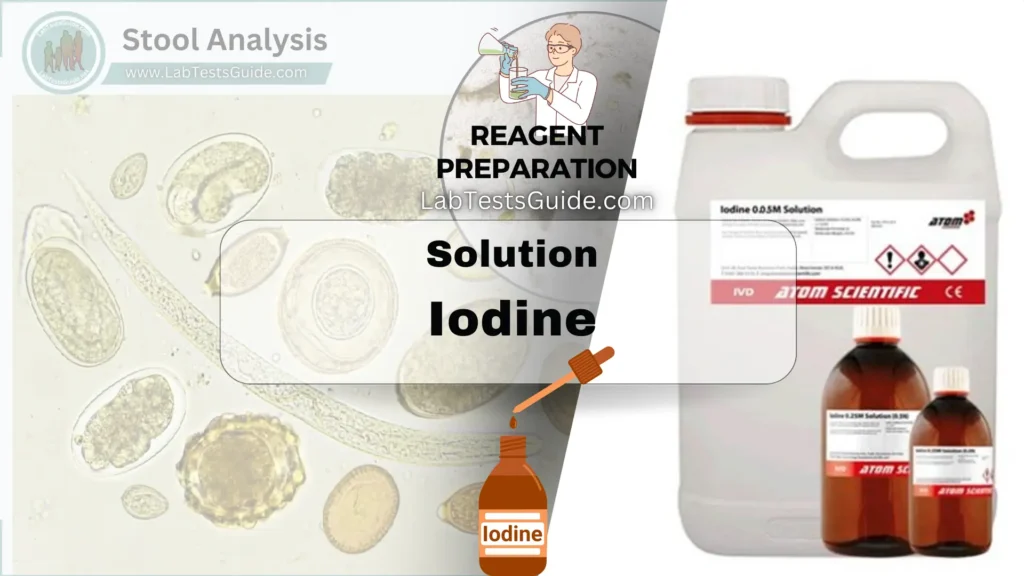Iodine is a halogen element with the chemical symbol I and atomic number 53. It is a dark gray or purple-black solid with a distinctive, pungent odor. Iodine plays a crucial role in various applications within clinical laboratories due to its antiseptic, staining, and chemical properties.

Uses of Iodine:
- Antiseptic: Iodine solutions, like povidone-iodine, are commonly used to disinfect wounds and prevent infections.
- Thyroid Health: Iodine is essential for the synthesis of thyroid hormones, which regulate metabolism and growth.
- Diagnostic Imaging: Iodine compounds are used as contrast agents in radiographic imaging, such as CT scans, to enhance the visibility of internal structures.
- Chemical Reactions: Iodine is used as a reagent in various chemical reactions and assays, including the iodine test for starch.
- Water Purification: Iodine tablets or solutions are used to purify drinking water, especially in emergency situations or outdoor activities.
- Disinfectant: Iodine is used in industrial and laboratory settings for disinfecting surfaces and equipment.
- Preservation: Iodine is used in some food preservation processes, such as iodized salt, to prevent iodine deficiency.
- Pharmaceuticals: Iodine is used in the production of certain medications and supplements.
Composition of Iodine:
| Component | Amount |
|---|---|
| Potassium iodide | 4 g |
| Iodine | 2 g |
| Distilled water | 100 ml |
This solution typically creates an iodine tincture or iodine solution used in various laboratory and medical applications.
Preparation of Iodine:
- Dissolve: Weigh and dissolve 4 g of potassium iodide in 50 ml of distilled water.
- Add Iodine: Weigh 2 g of iodine, add to the solution, and mix until dissolved.
- Complete Volume: Add remaining distilled water to reach 100 ml, then mix.
- Store: Transfer to a brown bottle, label as “Harmful,” and store in a dark place at room temperature.
- For Use: Transfer to a small brown bottle with a dropper.
Precautions:
- Ventilation: Work in a well-ventilated area to avoid inhaling iodine vapors.
- Protective Gear: Wear gloves, safety goggles, and a lab coat to prevent skin and eye contact.
- Avoid Inhalation: Do not inhale iodine vapors; use in a fume hood if available.
- Storage: Store iodine solution in a dark, cool place to prevent degradation.
- Labeling: Clearly label the container as “Harmful” to indicate its hazardous nature.
- Handling: Handle with care to avoid spills and splashes. If contact with skin or eyes occurs, rinse immediately with plenty of water and seek medical advice if necessary.
- Disposal: Dispose of any waste iodine solution according to local hazardous waste disposal regulations.
Uses of Iodine in Clinical Laboratories:
- Staining: Iodine is used in histology and microbiology as a staining agent. For example, it is a component of the Gram stain procedure to differentiate bacterial cell walls.
- Iodine Test: It is used in the iodine test for starch detection, which helps identify the presence of starch in various samples.
- Disinfection: Iodine solutions, such as povidone-iodine, are used for disinfection and antiseptic purposes on surfaces and skin prior to procedures.
- Preservation: Iodine can be used in preserving biological specimens by inhibiting microbial growth.
- Contrast Agent: Iodine-based contrast agents are employed in imaging studies, such as X-rays and CT scans, to enhance the visibility of internal structures.
Possible References Used





